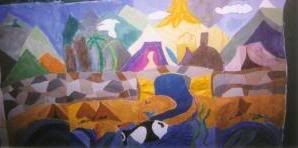My daughter asked me if I knew any words that rhymed with "lost." Other than using a rhyming dictionary, the most obvious method is to go through the alphabet: bossed, cost, dossed. Is dossed a word? I think it is, and an online dictionary says that it means going to bed. Which is perfect for poetry where the subject might want to bunk down, perchance to dream. And what about "dost?" The Internet says it is an archaic form of "does," I do, he dost. OK, yes, that sounds familiar, very "Prince and the Pauper." It turns out that she was writing a sonnet.
The main thing that I remembered about sonnets was that Sylvia Plath had science class anxiety, and she got her counselor to excuse her from having to enroll. But she found the atmosphere in study hall to be something like Mark Twain`s description of a Lacrosse game: two armies beating each other with sticks, with a hard missile occasionally denting someone`s head. So she asked the chemistry teacher if she could audit his class, and spent the sessions looking up to smile sweetly at him while writing sonnets and villanelles.
There are roughly three styles of sonnet, with the Shakespearean form being the favorite of ninth-graders. Maddy showed me a few well-known examples, all of which I recognized. I tried reading one out loud, and she said that I was not following the soft/hard pattern of iambic pentameter. Her English teacher recommends "head banging" to get the rhythm right. This rhythm can also be achieved by channeling Bela Lugosi, or the Sesame Street Count, or any Italian speaker. Also, each line must have ten syllables.
Your teacher said that you should bang your head
But I prefer to wave my arm instead
Yes, incorporating movement really did allow me to get into the sonnet groove. And as I shall be going to a service tomorrow where everyone has been asked to bring a rock or a feather or a quotation
OR A POEM
It seems only fitting to appear with my first ever Sonnetic effort.
today we mark the new year of the trees
wet sap awakens, hidden within bark
in two months the stubborn leaf buds it frees
shall burst knifelike and pallid in the park
soon greenish fronds seek sun to synthesize
added mass of stems, that bloom and set seed
winter shards cover up in springtime guise
avian creatures weave a house of reed
plantlike, sometimes emotion hibernates
when weather harsh restricts love`s easy flow
until hormonal heat initiates
capillary action`s flowery show
red rose hips in a scape barren of sprigs
a lone preserve: fall`s fruit upon stark twigs
Subscribe to:
Post Comments (Atom)







No comments:
Post a Comment